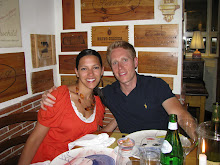Saturday, March 3, 2012
Pasta alla Norma
I often think of Sicily, though I've never been there. From scenes of Corleone in the Godfathers (scenes I think were actually shot in Savoca on the other side of the island), to books on the burgeoning scene of reactionary wine makers going back to contadino roots, I really want make a trip of it some day. For now though, I keep reading up and drinking the island's biodynamic wines, allowing me to sip what Sicily might taste and smell like, now or 50 years ago.
Norma's pasta is comprised of elements you'd find from Rome to Tunisia, but in the romantic way Italians like to identify time honored dishes, it's an ode to Bellini's heroine from the opera of the same name. I won't pretend to know much about that though. I used to think it was called pasta all nonna (grandmother), which would have probably had a nicer back story for me, but maybe some day I'll be more into opera.
Anyway, something kind of wonderful happens when the strands of pasta, just thinly coated with tomato in my version, dance in your mouth with the bitter/sweet fried eggplant and the bold creaminess of good ricotta salata, or fresh feta, which I used.
My advice would be to get smaller eggplants, Japanese, graffiti, something without too many seeds. And, for me at least, good ricotta salata can be hard to come by around the shire...the brands I often find are chalky and dry, not akin to my fond recollections of what it should be, which is a little moist and not too crumbly. So I opted for a fresh goat's milk feta recently, which I thought worked beautifully; tangy and salty, a little going a long way. Look for fresh stuff, often packaged in brine.
Fry eggplant, 3 smallish ones, in the usual way: cut them, skin on, into 1 inch cubes, toss with an abundant amount of salt, and lay them out on something perforated, or in a colander, for instance, for 45-90 minutes so that some of the brown water drains out. Then rinse them with cold water and pat dry to eradicate any excess liquid. Heat 1 1/2 to 2 inches of frying oil of your choice in a heavy pot, and fry the eggplant, in batches, until golden brown, then drain on absorbent paper. You shouldn't need to salt them since they retain some from the initial salting, but season as you feel necessary.
Make a quick tomato sauce by sauteing 2 medium cloves of garlic, thinly sliced or minced, in abundant olive oil (I don't know a measurement, so I'll say like 4 full gyrations of the bottle into the fry pan) with a few pinches of hot pepper flakes, and before the cloves even begin to brown, add 1 32 oz. can San Marzano tomatoes, by hand, separating the whole pieces and breaking them up, reserving the excess liquid. If you like a saucy sauce, something that will coat the pasta to a degree beyond salad dressing to greens, then add the tomato liquid previously reserved (remember though that you can increase sauciness at the end of the dish with pasta water). This only needs to cook 15-20 minutes, then season to taste with salt, and pepper if you like.
Cook 1 lb. of pasta in well salted water (almost any kind of dried pasta will work except for really small shapes), and when al dente, toss in the pan in which you made the sauce, or in a serving bowl to coat, adding pasta water if necessary, for the right consistency. Throw in a good handful of fresh basil, torn by hand, and some glugs of extra virgin olive oil for good measure. Then either gently fold the delicate eggplant into the pasta, or just serve it atop each plating, allowing the diners to mix it in themselves. Grate or crumble ricotta salata or feta on top and serve.
Labels:
Recipes
Subscribe to:
Comments (Atom)




